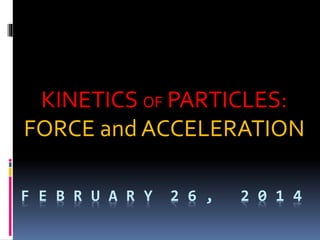
Kinetics of particles
- 1. F E B R U A R Y 2 6 , 2 0 1 4 KINETICS OF PARTICLES: FORCE and ACCELERATION
- 2. 2 Main Factors that affect motion in an Object 1. The Forces acting on an object 2. The Mass of an object
- 3. Mass – amount of matter in an object - property of an object that specifies how much resistance an object exhibits to change in velocity Acceleration – is the rate of change of the velocity Force – push or pull of an Object – according to Isaac Newton, these are what causes any change in the velocity of an object at the same time, it causes acceleration.
- 4. Newton's Laws Newton described force as the ability to cause a mass to accelerate. First law: When the sum of the forces acting on a particle is zero, its velocity is constant. In particular, if the particle is initially stationary, it will remain stationary. Or if it moves with constant speed in a single direction. Second law: The rate of change of linear momentum of an object is directly proportional to the applied force F and the object moves in the direction in which force F is applied. If the mass is constant, the sum of the forces is equal to the product of the mass of the particle and its acceleration. F = ma
- 5. Newton's Laws Third law: The forces exerted by two particles on each other are equal in magnitude and opposite in direction. F2 = −F1 4th Law : Newton’s Gravitational Attraction This law governs the gravitational attraction between any two particles/bodies.
- 6. Newton's 2nd Law of Motion The force and acceleration are directly proportional, the constant of proportionality can be determined in the ratio m = F1 / a1, on the other hand if another force of different magnitude say, (F2) is acted on an object, it will create another acceleration say, a2 such that m = F2 / a2… Thus, m serves as the constant of proportionality. Equation of Motion F = ma
- 7. In the case that 2 or more forces acting on a particle, the resultant force is determined by a vector summation of all the forces. FR = F Generally, the equation of motion is written as F = ma Static Equilibrium: F = 0 FR = F = 0 thus , a = 0 Dynamic Equilibrium: FR = F = ma F – ma = 0
- 8. Equations of Motion: Rectangular Coordinates In a x,y & z frame of reference, the forces acting on a particle can be expressed in terms of i, j, k components, so we have F = ma Fx i + Fy j + Fz k = m ( ax i + ay j + az k ) To satisfy the given condition with its respective i, j, k components: Fx = max Fy = may Fz = maz
- 9. F R I CT I O N : If the particle contacts on rough surface, it is necessary to use the frictional equation, which relates the coefficient of Kinetic Friction µk to the magnitude of the Frictional Force (Ff) and Normal Force (N) acting on the surface of contact, Ff = µk N Where: Ff - frictional force acting opposite the subjected Force µk - coefficient of kinetic friction N - normal force - force acting perpendicular to the point of contact.
- 10. The 50 kg crate rests on a horizontal plane for which the coefficient of kinetic friction is µk = 0.3 . If the crate is subjected to a 400-N towing force 30⁰ from the horizontal, determine the velocity of the crate in 5 sec starting from rest. EXAMPLE # 1
- 11. The 100 kg block A is released from rest. If the mass of the pulleys and the cord are neglected, determine the speed of the 20 kg block B in 2 seconds. EXAMPLE # 2
- 12. At a given instant the 10 kg block A is moving downward with a speed of 6 m/s. determine its speed 2 sec later. Block B has a weight of 4 kg, and the coefficient of kinetic friction between it and the horizontal plane is µk = 0.2 . Neglect the mass of the pulleys and cord. EXAMPLE # 3
- 13. Determine the time needed to pull the cord at B down 4 m starting from rest when a force of 10 kg is applied to the cord. Block A weighs 20 kg. Neglect the mass of the pulleys and cords. EXAMPLE # 4
